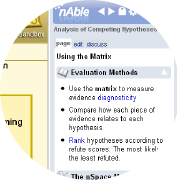Uncharted Research
Anatomy of an Adaptive Scaffold for Analysts
Adaptive user interfaces offer the potential to improve the learnability of software tools and analytic methodologies by tailoring the operation and experience to a user’s needs. Scaffolding is an instructional strategy that can be applied by adaptive interfaces to achieve this. Scaffolding theory suggests that the level of guidance should be adjusted to optimize learning and performance levels. This paper explores the use of adaptive techniques to scaffold user interaction and presents a taxonomy of techniques for adaptive scaffolds within complex software systems. The techniques identified in the proposed taxonomy can help software scaffolds select appropriate adaptations in response to the user’s learning and operating needs. A scaffold called nAble was implemented to explore the application of adaptive techniques from the taxonomy to support an analysis methodology called the Analysis of Competing Hypotheses (ACH).
